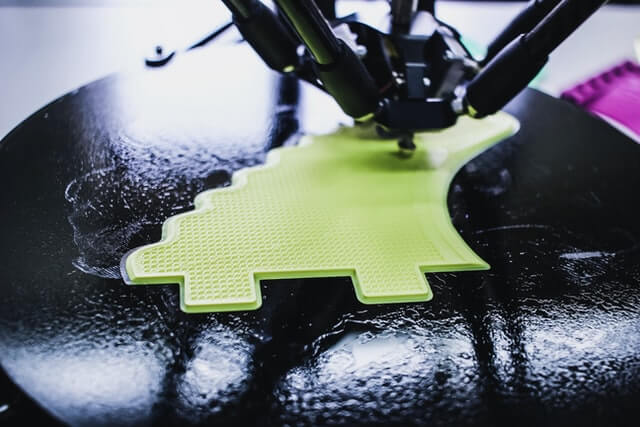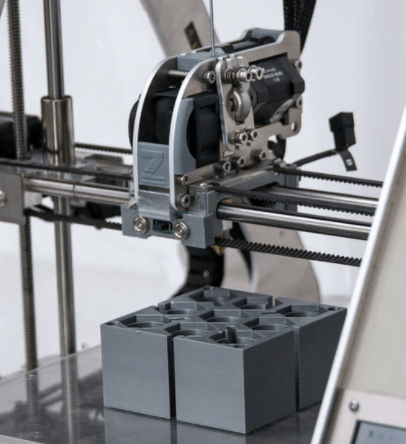PLA vs ABS is a long debate and you might want to know the difference between the two and their uses.
PLA and ABS are thermoplastic materials in general. But the two differ in chemical and physical properties. PLA is stronger, stiffer, and less heat-resistant in comparison to ABS which is an amorphous compound.
Both PLA and ABS have wide applications in 3D printing, prototyping, and manufacturing. And sometimes it’s a bit difficult to decide which material is applicable for your project.
In this article, we will talk about specific differences between PLA and ABS in detail and will find out the important properties of each material. Reach on to find out.
What is PLA?

PLA is an abbreviation of Polylactic Acid. Mainly used as a 3D printing filament, it is a viable bioplastic material manufactured by organic sources. 3D printers love it because of its easy handling nature, sustainability, and low price.
It gives a shiny (glossy) glow to the surfaces. For a long time, it has been a standard-bearer for complex 3D prints.
Due to its easy to use nature and low-melting temperature, PLA is the best 3D printing material for beginners. Students and trainees mostly use it in their thesis, educational work, and practice.
PLA has higher stiffness than its peers i.e. ABS and Nylon but its low heat-resistant property makes it vulnerable in hot conditions. This is the reason PLA is commonly restricted to hobbyist applications.
What is ABS?

ABS is an abbreviation of Acrylonitrile Butadiene Styrene. It is a heat resistant thermoplastic used in 3D printing applications. Because of stiffness, 3D printed parts of ABS can withstand high mechanical stresses.
ABS is used way more than just for hobbyist purposes due to its durability, lightweight, and more heat-resistance than PLA.
However, a 3D printer will need to make more effort when using ABS as a filament. In other words, a heated bed and a hot extruder (220-250°C) are needed to print.
Furthermore, ABS is less prone to warping which makes it a sound material for practical applications such as consumer goods, gears, household, and vehicle interiors – almost everywhere.
How Strong is a 3D Printed PLA Object?
PLA has a tensile strength of 7250 psi. It is tough and can bear a considerable elastic load (one tiny bar can hold 1 kg.) However, the PLA printed object will decay faster in high temperatures and with microorganisms.
By looking at the PLA’s tensile strength digit, it’s obvious that PLA can bear high-pressure loads without breaking or generating cracks.
It’s the most blessed feeling for a 3D printer to safely say that the future of 3D printing is secure with PLA and there is a lot more room for research and improvements.
How Strong is a 3D Printed ABS Object?
ABS has a tensile strength of 4,700 psi which is lesser than the PLA. But with considerable durability and heat resistance, ABS makes it into the list of best 3D printing materials. ABS’s strength may vary due to the manufacturing conditions of the material (process parameters.)
Strength depends on the orientation of printing. If the orientation slightly changes, the strength will vary too.
Hence, it turns out that the ABS filament is weaker than the PLA for 3D printing applications in terms of tensile strength.
Differences Between PLA & ABS Material
Now that we are familiar with the basic introduction of PLA and ABS. Let’s dive deeper into some differences and specific property comparisons for PLA vs. ABS comparison.
Difference #1 – Strength
When comparing ABS with PLA for strength, ABS seems to be winning the race with flying colors. It’s not only strong but can also fit well in hot working conditions. Moreover, it can bear vibrations, pressure, impact loads, and microorganisms.
On the other hand, PLA is, of course, weaker and can’t compete with PLA for stiffness and heat resistance.
3D printed materials are often checked for water resistance too. And for most consumer applications, materials that are vulnerable to water and humid conditions don’t suit. Unfortunately, PLA is one of them, and again, ABS is securing its first place comfortably here.
Difference #2 – Ductility
ABS is more ductile than PLA and it has an extremely wide range of percentage elongation. For most industrial 3D printing applications, product designers chose ABS due to the ductility.
ABS is commonly employed where the function is more of a concern than the shape or look. The ductility of ABS brings more flexible opportunities for the engineers to design the shapes even better.
Without breaking, ABS can extend to an astonishing limit i.e. more than ten times the PLA material. Very few filaments can reach this elastic limit and ABS is one of them. Its flexural strength makes it an ideal choice for end-use applications.
Difference #3 – Durability/Heat Resistance
The printed ABS products are more durable than PLA. We are talking about the durability in the sense of heat resistance. ABS performs better in response to hotter conditions and therefore, it’s best to use for products exposed to sunlight and warm environments.
PLA printed material will start deforming when left in a direct sunlight spot. You wouldn’t want a melted car interior, right? That’s why PLA is not suitable for this application. And often ignored in front of ABS for durability.
Although ABS bow down to high temperatures too, it requires much more than what it takes for PLA. So, in a nutshell, ABS has a lead.
The melting temperature for PLA is 50°C as compared to ABS which has much higher heat resistance. It’s hard to melt ABS completely because of its amorphous nature.
Difference #4 – Degradability
It’s quite obvious that PLA is biodegradable as it is bioplastic and consists of renewable raw materials.PLA is extremely beneficial for mother nature in times where most plastics are poison for the wildlife and their ecosystem.
But PLA compost hasn’t become a usual thing as the world doesn’t have an infrastructure for it.
In contrast, ABS isn’t degradable. However, it can be recycled.
Unfortunately, the recycling of ABS isn’t very common yet but we are seeing most metropolitan 3D printing services using ABS recycling which is a good sign. And we hope to see more coming forward in the future.
Difference #5 – Price
Although ABS and PLA have quite a range of different physical and chemical properties, prices don’t seem to deviate much.
Both the materials are available in markets for a price between $22 and $35 per kg.
You might get a cheaper quote than that, but it might cost you a bad quality printout having cracks or pores which is certainly not acceptable for industrial applications.
Exotic filaments might be a bit pricey as expected but overall, the price range for both materials is the same and consistent.
Difference #6 – Uses
ABS and PLA are both plastics but have a different set of uses/applications. ABS is more of common material for practical examples but PLA is mostly employed in prototyping and aesthetics.
Because of its rigid nature, engineers use ABS for manufacturing purposes. It can bear excessive impact loads therefore, it is used in protective gears and products. Phone cases and automotive parts are also manufactured by ABS 3D printing.
Some other common industries for ABS applications are electronics, construction, home appliances, and safety.
Mechanical and thermally vulnerable projects rely on ABS but if the model is only for aesthetics and visuals, PLA will be the perfect candidate. Casting molds, concept models, and technical prototyping are common examples of PLA applications.
Difference #7 – Tolerance and Accuracy
Tolerance and accuracy limits depend on the 3D printers but material properties can give them a slight change in practicality.
For example, due to the warping effect, ABS is more difficult to print as compared to PLA filament. ABS parts won’t give you sharp corners and perfect shapes as PLA because of the high printing temperature.
Difference #8 – Post Processing
As you might know, print layers are commonly visible after the 3D printing process which you must remove to give a decent surface finish.
PLA gives a smoother texture and sem-transparent surface in comparison to ABS matte finish. To make the ABS smooth and glossy, acetone is used.
As far as machining is concerned, ABS doesn’t require as much care as a PLA printed piece would do. So you must be very delicate when drilling, sanding, and cutting to keep the stresses under the allowable range.
For aesthetically good-looking prints, one must use material jetting 3D printing.
Conclusion
To get a small overview of a long text, here’s what we have covered in this article.
ABS (Acrylonitrile Butadiene Styrene) has industry wide-applications because of its in-demand physical and chemical properties that make it the perfect choice of material for consumer parts.
PLA (Polylactic Acid) is a bioplastic made by organic sources. It’s best to use in 3D printing where aesthetics are a big concern over functionality and durability.
This guide of PLA vs. ABS materials is only to give a brief overview. In the end, it’s your choice to have a material that suits your reason for printing.
Related Content
23 Engineering Tools You Should Know About (Physical Tools)
Now We’d Like to Hear From You
There you have it: PLA vs ABS.
Now we’d like to hear what you have to say:
What material do you use to 3D print with, PLA or ABS?
Or maybe you use a different material for your creations.
Either way, let us know by leaving a quick comment below.

